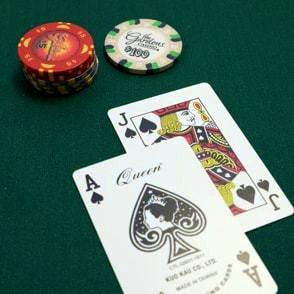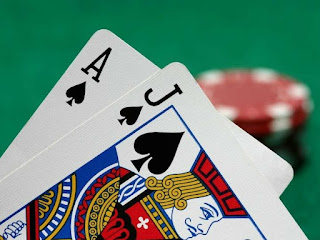How to play Blackjack
However, in any event, for the relaxed member who plays a sensibly decent game, the gambling club chances are less, making Blackjack one of the most appealing club games for the player. While the prevalence of Blackjack dates from World War I, its underlying foundations return to the 1760s in France, where it is called Vingt-et-Un (French for 21). Today, Blackjack is the one game that can be found in each American club. As a well known home game, it is played with marginally various standards. In the gambling club form, the house is the seller (a "extremely durable bank"). In gambling club play, the seller stays standing, and the players are situated. The vendor is responsible for running all parts of the game, from rearranging and managing the cards to taking care of all wagers. In the home game, each of the players have the chance to be the seller (a "evolving bank").
THE PACK
The standard 52-card pack is utilized, yet in many club a few decks of cards are rearranged together. The six-deck game (312 cards) is the most well known. Furthermore, the seller utilizes a clear plastic card, which is rarely managed, however is set toward the lower part of the pack to demonstrate when it will be the ideal opportunity for the cards to be reshuffled. At the point when at least four decks are utilized, they are managed from a shoe (a container that permits the seller to eliminate cards each in turn, face down, without really holding at least one packs).
OBJECT OF THE GAME
Every member endeavors to beat the seller by getting a consider near 21 as could be expected, without going more than 21.
CARD VALUES/SCORING
It is up to every individual player if a pro is worth 1 or 11. Face cards are 10 and some other card is its pip esteem.
Wagering
Before the arrangement starts, every player puts down a bet, in chips, before them in the assigned region. Least and greatest cutoff points are set up on the wagering, and as far as possible are from $2 to $500.
THE SHUFFLE AND CUT
The seller completely rearranges segments of the pack until every one of the cards have been blended and joined. The vendor assigns one of the players to cut, and the plastic addition card is put with the goal that the last 60 to 75 cards or somewhere in the vicinity won't be utilized. (Not managing to the lower part of the multitude of cards makes it more hard for proficient card counters to work adequately.) 안전한카지노사이트
THE DEAL
At the point when every one of the players have put down their wagers, the vendor surrenders one card face to every player in pivot clockwise, and afterward one card face dependent upon themselves. One more round of cards is then managed face up to every player, except the vendor requires the subsequent card face down. Consequently, every player aside from the seller gets two cards face up, and the vendor gets one card face up and one card face down. (In certain games, played with just one deck, the players' cards are managed face down and they will hold them. Today, notwithstanding, practically all Blackjack games include the players' cards managed face up depending on the prerequisite that no player might contact any cards.)
NATURALS
In case a player's initial two cards are an ace and a "ten-card" (an image card or 10), giving an include of 21 of every two cards, this is a characteristic or "blackjack." If any player has a characteristic and the seller doesn't, the vendor quickly pays that player one and a half times the measure of their bet. If the vendor has a characteristic, they promptly gather the wagers of all players who don't have naturals, (yet no extra sum). If the seller and one more player both have naturals, the bet of that player is a deadlock (a tie), and the player reclaims his chips.
In case the vendor's face-up card is a ten-card or an ace, they take a gander at their face-down card to check whether the two cards make a whiz. If the face-up card is definitely not a ten-card or an ace, they don't take a gander at the face-down card until it is the seller's chance to play.
THE PLAY
The player to one side goes first and should conclude whether to "stand" (not request another card) or "hit" (request one more card trying to draw nearer to a count of 21, or even hit 21 precisely). Accordingly, a player might remain on the two cards initially managed to them, or they might ask the vendor for extra cards, each in turn, until choosing to remain on the aggregate (in case it is 21 or under), or goes "bust" (in case it is more than 21). In the last case, the player loses and the seller gathers the bet. The seller then, at that point, goes to the following player to one side and serves them in a similar way.
The mix of an ace with a card other than a ten-card is known as a "delicate hand," on the grounds that the player can consider the ace a 1 or 11, and either draw cards or not. For instance with a "delicate 17" (an expert and a 6), the complete is 7 or 17. While a count of 17 is a decent hand, the player might wish to draw for a higher aggregate. If the draw makes a bust hand by considering the ace a 11, the player just considers the ace a 1 and keeps playing by standing or "hitting" (asking the seller for extra cards, each in turn).
THE DEALER'S PLAY
At the point when the vendor has served each player, the sellers face-down card is turned up. If the absolute is at least 17, it should stand. In the event that the all out is 16 or under, they should take a card. The seller should keep on taking cards until the complete is at least 17, so, all things considered the vendor should stand. If the vendor has an expert, and considering it 11 would carry the all out to at least 17 (however not more than 21), the seller should consider the pro 11 and stand. The vendor's choices, then, at that point, are programmed on all plays, while the player consistently has the choice of taking at least one cards.
Flagging INTENTIONS
At the point when a player's turn comes, they can say "Hit" or can flag for a card by scratching the table with a finger or two in a movement toward themselves, or they can wave their hand in the very movement that would say to somebody "Come here!" When the player chooses to stand, they can say "Stand" or "No more," or can flag this expectation by moving their hand sideways, palm down and simply over the table.
Dividing PAIRS
In case a player's initial two cards are of a similar category, for example, two jacks or two sixes, they might decide to regard them as two separate hands when their turn comes around. The measure of the first wagered then goes on one of the cards, and an equivalent sum should be put down as a bet on the other card. The player first plays the hand on their left side by standing or hitting at least multiple times; really at that time is the hand to the right played. The two hands are subsequently treated independently, and the vendor settles with each on its own benefits. With a couple of aces, the player is given one card for each ace and may not draw once more. Additionally, if a ten-card is managed. 바카라사이트

.jpg)


Comments
Post a Comment